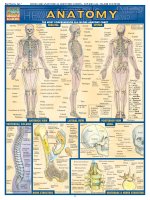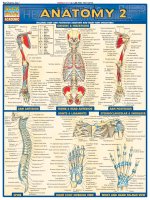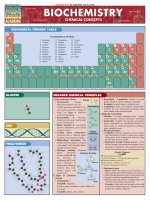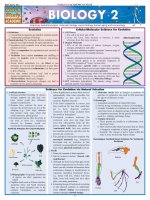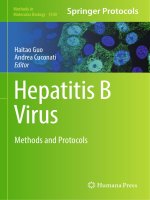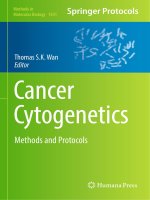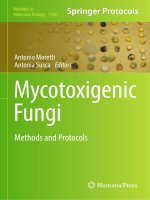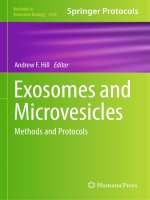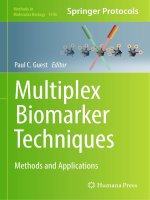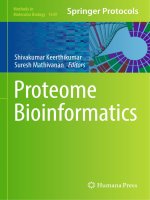barcharts quickstudy biology vol 2
Bạn đang xem bản rút gọn của tài liệu. Xem và tải ngay bản đầy đủ của tài liệu tại đây (1.4 MB, 6 trang )
2. Either flightlessness in these birds evolved
independently three times (possible, but
improbable) or they arose from a
common, flightless ancestor
3. If the latter explanation is correct, and
they could not fly, how then could they
get to these disparate southern
continents while being excluded from
the northern hemisphere?
4. Geological evidence indicates the
continents were once one large land
mass that subsequently broke up into
pieces (
plate tectonics) that mo
v
ed
(
continental drift) first into northern
and souther
n portions, and later into the
present-day continents
5.
This geological concept also explains why
marsupial mammals (e.g., kangaroos)
de
v
eloped onl
y on Australia, as this
continent was geo
graphically isolated from
areas where
placental mammals e
v
olv
ed
C.
Fossils
1. Preserved remnants of dead organisms
2. Darwin termed evolution “
descent with
modification
”
3.
Although the fossil record has g
aps (some
structures/organisms do not fossilize well),
fossils pro
vide v
aluable information about
e
volutionary changes or modifications in
organisms (including transitional forms,
e.g., horses with toes, whales with hind
limbs, ferns with seeds) that have taken
place over many generations
4. Estimating the age of fossils involves looking
at their physical positions in sedimentary
rocks (
relative dating) and radiometric
isotope techniques (
absolute dating)
A.Artificial selection
1. Human-controlled breeding of species
strongly supports the idea that, over
time, nature could also influence
changes in populations
2. Humans have selected for traits to
increase the attractiveness (to us) of the
offspring (e.g., “cute” dogs, chickens
that produce many eggs, wheat that
yields numerous, plump grains)
3. Domesticated species often do poorl
y in
the wild, as traits (i.e., variations)
selected by humans would not
necessaril
y be adv
antageous in nature
B
.
Bio
g
eo
graphy:
Geo
g
raphic distrib
ution
of species can show organisms are
related
1.
Flightless birds, such as
African ostriches,
Australian emus, and South
American
rheas are found (naturall
y) onl
y in the
souther
n hemisphere; on separate
continents
Evidence for Evolution via Natural Selection
A.Definitions
1. Concept that all organisms are related by common ancestry
2
. Fundamental paradigm of biology
B.
Natural selection: The mechanism for how evolution occurs
1. Species have high potential for rapid reproduction
2
. Population sizes eventually level off and remain fairly
constant over time
3. There is
competition for reproduction and survival of
o
ffspring
4.
Variations (from random mutations and shuffling of
genes via
meiosis) exist in behavior, physiology,
structure, etc.
5. Nature selects individuals (i.e., the
fittest or just
fortunate) for survival and reproduction to pass these
favorable characteristics (
adaptations) via their genes
to their offspring
6. Over time, natural selection “can” lead to genetic
changes in populations – i.e., evolution
7.
Microevolution: Small-scale changes
8.
Macroevolution: Larger-scale changes; can lead to
evolution of new species and groups
5. Molecular clocks look at changes in portions of
genomes of organisms; also used to help determine
the age of evolutionary events
D.
Homologies
1. Anatomical similarities of related life forms
2. Provide strong evolutionary evidence of relatedness
3. Example: Forelimbs of vertebrates are composed of the
same basic bones in disparate groups, but differ based
on adaptations necessary for the specific environmental
needs (i.e., walking, swimming, flying)
4.
Vestigial structures
a. Those present are usually in a rudimentary, non-
functional form
b. Show anatomically-related structures that are likely
to disappear completel
y in future generations
c. Example: The vestiges of pelvic bones within the
body in some modern-day baleen whales
C
ellular/Molecular Evidence for Evolution
A.Cell Theory
1. The cell is the basic unit of life
2. Every life form, from bacteria to humans, is made
of/comes from this basic structure
B.
Organic Molecules
1
. 99% of all life consists of carbon, hydrogen, oxygen,
nitrogen, phosphorus and sulfur
2. Evolutionary relatedness explains organisms’ common usage of
a
small subset of over 90 available elements
C.
DNA
1. Genetic, informational molecule in every organism, including
viruses (which appear to be molecular fragments of
DNA/RNA capable of “living” in host cells)
2. DNA “language” (
genetic code) is essentially universal
(slightly different dialects exist in some single-celled organisms
and in some mitochondrial/chloroplast
genomes)
3. A common genetic language allows for such phenomena as
the insertion of human genes into bacteria, which can then
produce “human” proteins (see
Molecular Biology)
D.
ATP (Adenosine triphosphate): The primary energy currency
molecule used by every organism
DNA Double Helix
Wild mustard
Broccoli
Cauliflower
Cabbage
Kohlrabi
Brussel sprouts
Kale
Artificial Selection For Crop Production
Human
Dolphin
Bat
Homologous Forelimb Bones: Evidence for Vertebrate
Evolution
B
arCharts, Inc.
®
W
ORLD’S #1
A
CADEMIC OUTLINE
1
F
eaturing: Evolution/origins, molecular biology, cancer biology, human aging and immunology
Evolution
Pig
A
.Where do humans fit in the evolutionary
s
cheme?
B.Some of the greatest evidence for
evolution is seen when comparing
vertebrate chordates, which include
humans (see
Homologies, Evolution &
Natural Selection)
C
.
C
omparative anatomy of adults
1
. Obvious visual similarities in adult
v
ertebrates (i.e., eyes, ears, mouth,
nose, appendages) link humans to
other vertebrates, especially the
great apes
D.
Comparative embryology
1. Earnst Haeckel coined the phrase
“ontogeny recapitulates phylogeny,”
suggesting the false claim humans
start as fish, then progress through a
series of developmental stages that
retrace the lower vertebrate groups
before becoming human
2. Early developmental stages of
humans share remarkably similar
vertebrate characteristics that either
disappear or become vestigial in
adult humans
H
uman Origins
a. Gill (pharyngeal) slits (they occasionally do not
close in infants –
cervical (branchial) fistulae –
may require surgery)
E.
Vestigial structures
1. Show clear links to vertebrate ancestry and include
the following non-functional structures:
a.
Tail bones (coccyx)
b.
Ear muscles (function in other mammals)
c.
Nictitating membrane (3
r
d
eyelid in some
vertebrates)
d.
Pointed canine teeth
(continued pg.3)
E. Variations in Life
1. In England, the peppered moth shifted from
predominantly light coloring to dark when air
pollution darkened the trees on which it lives
2. Predators can easily spot moths that contrast
with their background, limiting the abundance
of these types of moths in the population
3. Subsequent air quality measures have
lightened trees and light-colored moths are
again the predominant form
4. Additional examples of selection observed in
living organisms involve increasing drug
resistance: e.g., bacteria-antibiotics, insect-
insecticides and HIV-drug therapies
Evidence for Evolution
via Natural Selection cont.
A.The ultimate spark of life may never be known
but science provides a controversial scenario of
how life “might” have arisen
B.
Universe/Earth origins
1. First, the universe had to be formed,
theoretically via the
Big Bang about 16-18
billion years ago
2. Geologic and other physical evidence date the
earth’s origin to about 4.6 billion years ago
3. The crust and
biosphere (thin portion of
earth where life exists) would not be
habitable (too hot) for nearly a billion years
C.
First cells: How did they form?
1.
Early hypotheses suggest life arose
spontaneously from simple molecules (e.g.,
CO
, CO
2
, N
2
, H
2
O) that combined into lar
ger,
complex macromolecules such as proteins,
carboh
ydrates, lipids and nucleic acids
2. Some rocks from outer space (meteorites)
ha
v
e pre-formed comple
x or
ganic
molecules, including the five nitrogenous
bases that mak
e up DNA/RNA
3. Whether life was seeded from outer space
(
panspermia), or macromolecules were
synthesized entirely on earth, the next step
was to incorporate these organics into cells –
the basic functional units of life
4. These first life forms were likely
heterotrophs,
w
hich consumed the ab
undant food molecules
present in the “
primordial soup”
5. Later, photosynthesis (by
autotrophs)
developed and oxygen levels began
increasing in the atmosphere
6.
The oldest fossils disco
v
ered (aged 3.8
billion years) consist of photosynthesizing
bacteria called
str
omatolites
, w
hich still
have representatives in colonies that form
large, calcareous structures in some shallow,
tropical oceans
ii.
Mitochondrial DNA is more like
present-day bacterial DNA than the
nuclear DNA of the cell in which it
resides
iii.
Chloroplasts have their own genomes
iv. Today, living organisms provide
numerous examples of symbiotic
relationships between single-celled
organisms; sometimes including
bacteria that perform the role of
mitochondria in cells lacking ATP-
producing organelles
7. Eukaryotic cells subsequently evolved into
protists, fungi, plants and animals
8. Prokaryotes continued to thrive and, though
microscopic, are among the most successful
groups of organisms on earth
F
ish
Generations of Peppered Moths Changed Color
t
o Match Habitat
Embryonic Similarities Among Vertebrates
Reptile Bird Human
G
ill (pharyngeal) slits
Tail
Tail
Host Prokaryotic Cell
Aerobic bacteria
ingested
Plants, certain protists
Evolution of Eukaryotic Cells
Animals, fungi,
certain protists
Aerobic bacteria
develop into
mitochondria
Photosynthetic
bacteria
ingested &
developed
into chloroplasts
2
Eukaryotes
D. Oxygen crisis and the endosymbiotic
hypothesis
1. Geologic evidence supports increasing
o
xygen levels via photosynthesis-created
“rust” zones at similar ages in ancient sea
beds worldwide
2. Chemically, oxygen is a corrosive element
to organic molecules as well, and likely
created a crisis for many of the earliest
life forms
3. Some bacteria evolved a metabolic pathway
that could neutralize as w
ell as produce
A
TP
energy from this highly-reactive oxygen
4.
Symbioses for
med betw
een these o
xygen-
consuming, ener
gy-producing bacteria and
other larger
, soft-bodied bacteria that lack
ed
protection against the effects of oxygen
5. This was the birth of the
eukaryotic cell,
from
prokaryotic ancestors; one of the
major evolutionary events in life
6.
This
endosymbiotic h
ypothesis
is suppor
ted
by the following facts:
i.
Mitochondria (use o
xygen for
metabolism) have their own set of DNA,
separate from that of the cell nucleus
Origins of Life
Stromatolites Form Aquatic Reefs
e. 3
r
d
molar teeth
f
.
H
air
(
plays major thermoregulation role
in most mammals)
g.
Nipples in males
h. Appendix (functions as digestive
caecum in many mammals)
i
.
S
egmented muscles of abdomen
j. Pyramidalis muscle (absent in 20% of
h
umans; arguably unnecessary; present
in other mammals)
Human Origins
3. From this origin in Africa, modern humans, Homo
sapiens, eventually arose
4
. Debate exists among paleoanthropologists about how to
arrange the phylogenetic tree of humans based on the
available fossils
5. Most agree that Neanderthals were the most recent group
of humans to become extinct, and were probably a
subspecies called
Homo sapiens neanderthalensis
6. From these origins, humans have spread to most land
a
reas on Earth
F.
Molecular Comparisons
1
. Comparison of DNA sequences in
h
umans and chimpanzees show
average similarity of 98.5%
2. Comparison of hemoglobin amino
acid sequences (the main carrier of
o
xygen in the blood of thousands
of different animals [by itself
evidence for evolution]) between
humans and other vertebrates show
the same evolutionary patterns as
t
hose with skeletal/physical
anatomy that is comparative, with
the great apes showing the greatest
similarity
G
.
F
ossil Record
1. Fossils show a transition from ape-
like forms to the first primitive
human forms that were truly
bipedal (walking on the pelvic
appendages or legs)
2. Modern apes are not bipedal, but one
of the oldest fossil forms (3.2 million
years) resembling an ape to
walk bipedally was named
Australopithecus afarenesis or Lucy
(named after a famous Beatles song)
A.The discovery that DNA is the informational molecule housing
genes started a revolution in biology
B.
Molecular biotechnology is now a pervasive component in
modern societies
Cloning
A.Gene Cloning
1. Making exact copies of genes
2. Involves two major processes:
a.
Recombinant DNA
i. Restriction enzymes create DNA fragments with the
gene of interest
ii. DNA fragments are fused with DNA from a bacterium
(
plasmid)
iii. Newly-created recombinant DNA is placed into bacteria
iv. Bacteria produce protein for which the “cloned” gene coded
v. Large quantities of the gene, and thus protein, are
produced as the bacterial cell reproduces
Molecular Biology
b. Polymerase Chain Reaction (PCR)
i. Amplifies (copies) a segment of DNA without using a bacterial (or other)
host organism
ii. DNA sample is heated until the double helix denatures (hydrogen bonds are
broken), separating the DNA into two single strands
iii. Heat-resistant, single-stranded DNA primers allow DNA polymerase to add
the appropriate nucleotides to each side of the separated DNA strands
iv. This process results in multiple copies of the original DNA
v. Repeating the process on the copies, via automation, can amplify a small DNA
fraction a billion fold in a short period of time
B.
Reproductive cloning
1. Produces living cells/organisms with exactly the same DNA in the nuclei as that
from a donor cell/or
g
anism
2.
Specif
icall
y
, DN
A from the nucleus of a
somatic cell of the donor is inser
ted into
an egg cell from w
hich the original nucleus has been remo
v
ed
3. The new egg cell is electrically or chemically stimulated to begin cell division and
embr
y
onic de
v
elopment
4.
The g
ro
wing embr
y
o is implanted into a female where development continues until birth
A
TG
A
T
A
C
T
A
TG
C
A
TG
A
T
A
T
G
C
A
T
G
C
A
T
A
T
A
TG
C
A
T
A
TG
C
A
T
A
T
G
C
A
T
G
C
A
T
A
T
A
T
G
C
A
T
G
C
A
T
A
T
Some Vestigial Structures in Humans
N
ictitating membrane
H
air
Nipples on
m
ale
Segmented
m
uscles of
a
bdomen
Gene Cloning using Recombinant DNA
Bacterium
1. Plasmid isolated
Gene of interest
Bacterium with Recombinant DNA
Recombinant DNA in plasmid
DNA containing
gene to be cloned
2.
DNA is fragmented
by enzymes
4. Plasmid inserted into a bacterial cell
3. Gene inserted into
isolated plasmid
Separate DNA strands by heating
T
wo new DNA molecules produced
Repeat above processes to
make multiple DNA copies
3
Spine
G
orilla
Human
P
elvis
Toes
A
nthropoid Skeletal Comparison
Using PCR to Amplify DNA
Primers add base pairs to DNA template strands
4
5. The new individual is not a true clone of the donor
organism, as the mitochondrial DNA is from the
organism that donated the egg
6
. Survival rates have been low as multiple factors
(mostly unknown) influence successful development,
such as source of donor cells
C.
Therapeutic cloning
1. Use of reproductive cloning to
create human embryos to procure
stem cells, which have potential to
develop into adult tissues
2. These special cells may hold the key
to treatments for many diseases
(
heart, cancers, Alzheimer’s,
P
arkinson’s) and afflictions (injury
t
o spinal cord, including paralysis)
3. Stem cells can also be retrieved from
human embryos produced by regular
fertilization processes (
in vivo or in
vitro
) or adults (e.g., bone marrow)
4. Stem cell procurement via cloning
a
nd embryos is a growing ethical
and political issue
A.Study of the structural and functional
aspects of the entire set of genes in a
species (i.e., genome)
B. Encompasses many different aspects of
approach
1.
Bioinformatics uses computer/statistical
applications to access large databases
concerning DNA/gene/protein information
2.
Proteomics studies the functioning of
the proteins coded by the genes
C.Several specific applications of genomics
will be discussed further below:
1.
Restriction Fragment Length
Polymorphisms (RFLP)
a. Technique relies on enzymes
discovered that protect bacteria from
“foreign” DNA of bacteriophages
(viruses specific for bacteria) and
other invading bacteria
b. These bacterial restriction enzymes
cut foreign DNA at specific points or
restriction sites, while protecting
their o
wn DN
A b
y adding special
“buffering” functional groups to
potentially susceptible areas
c.
Exact positions of restriction points
are highly individual, reproducible
and measurable
d.
DNA samples from the same
individual will produce the same
fragments, but these fragments will be
different from others (polymorphic)
e. Fragment patterns can be represented
visuall
y as a
DN
A f
ing
erprint
, b
y use
of special electrophoretic processes
f. RFLP is used frequently in forensic,
criminal and paternity applications
g. Because DNA samples may be minute
in some of these applications, PCR
amplification may be used to create
quantities necessary for RFLP analysis
h. A modified DNA fingerprint approach
has been developed using
polymorphisms of
satellite (repetitive)
DNA regions called Simple Tandem
Repeats
(STR)
3.
Gene therapy
a. Treating diseases and injury in humans
involves the use of harmless retrovirus
vectors (or other entry mechanisms)
that possess the enzyme
reverse
transcriptase
, allowing them to insert
genetic information “into” DNA
b. Normal information flow occurs
“from” the DNA
c.
These treatments raise ethical
questions, but certainly have
tremendous potential
d. Limited success and legal restrictions
using human subjects ha
v
e made
progress in this area challenging
4.
Genetic engineering
a. Research involving gene transfer in
non-human organisms has been much
more extensive
b.
Transgenic and genetically-modified
plants and animals are becoming more
common
c.
Great potential to artificially select
desirab
le traits in crops, f
ar
m animals, etc.
d.
Safety concer
ns are still high as this
new technology is incorporated into
modern society
2.
Human genome project
a. Monumental, historical effort to determine
the actual sequence of the entire set of
chromosomes in humans -
gene mapping
b
.
Inv
olv
ed o
ver 3 billion base pairs, which
if written, would create a book with a
half-billion pages and tak
e nearly a
lifetime to read
c. Several molecular techniques were
emplo
y
ed, with automated computer-
assisted analysis paving the way for a
rapid conclusion to the project
d.
Although the precise number of genes is
still unknown,
a priori estimates
suggested there w
ould be nearl
y 100,000
e. Actual number probably does not exceed
40,000, w
hich w
hen compared to simpler
organisms suggests human genomics is
extremely concise, but complex
f. Future studies will undoubtedly reveal
much about how genes function, which
should lead to numerous future benef
its
A
C
D
B
A
T
G C
A
T
TA
C
G
Cloning
D
onor organism
t
o be cloned
Unfertilized
e
gg cell
Differentiated
c
ells from donor
Clone is born
E
mbryo implanted
into uterus of female
D
evelop into embryo
E
gg cell
without
n
ucleus
Removal of
n
ucleus egg cell
Culturing Stem Cells
DNA fingerprinting using RFLP
Genomic Project-Mapped Human Genes
Using Retroviruses to Insert Healthy Genes
RNA
Healthy gene
Nucleus
DNA
Healthy gene
Gene
N
ucleus
B
loodstain
DNA removed
f
rom blood cells
D
NA fragmented
using restriction
enzymes
Radioactive
DNA probes
bind to
certain DNA
fragments
Membrane
is washed to
free excess
probe
X-ray film is
attached to
membrane to
detect radioactive
patterns
DNA fragments
are transferred
to a membrane
(Southern blot)
DNA fragments
are separated by
electrophoresis
DNA bonding
pattern of sample
is compared to
known subjects
Sheri sample
Alicia
1. In vitro fertilized egg
2
. Blastocyst stage
(5-7 days old)
3
. Stem cell from
i
nner mass
4
. Cultured,
undifferentiated stem
cells can be used to
p
roduce many kinds of
c
ells/tissues
e
.g., Blood cells
Molecular Biology cont.
Genomics
Retrovirus
D
onor & egg
c
ell fuse
O
ptional review
:
“
C
ell Reproduction” section, p.2 of
Quickstudy
®
Biology guide
A.
Cells reproduce by dividing primarily through two processes:
1. Mitosis: Nuclear division
2.
Cytokinesis: Cytoplasm division
B
. Cell division is part of the
c
ell cycle
,
which is under a
control system involving internal and external factors
C.
Cancer cells have escaped this regulatory process through
transformation and divide uncontrollably
D.
Tumors form, which may progress from a benign to a
m
alignant
s
tate and interfere with normal tissue functioning
E.
Metastasize: Initial tumor cells can spread and form more
malignant tumors in other tissues in the body
F.
Oncogenes stimulate abnormal cell growth and division,
which can lead to malignant tumors
1. These abnormal genes are converted from normal genes
(
proto-oncogenes) that regulate the cell cycle. Viruses
can also deliver oncogenes to cells
G.
Tumor-suppressor genes normally prevent the
uncontrolled gro
wth and division of cells and tissues
H.
Mutations are primar
y f
actors contributing to cancers
1.
Mutagens are any factors that can trigger mutations –
those that cause cancer are called
carcinogens
I. All tissues in the human body are susceptible to tumors,
because mutations (either induced by carcinogens or
inherited) can occur in any cell
J
.
Cancers are pre
v
alent and dif
ficult to cure (in most cases)
because of our limited kno
wledge about:
1.
F
actors controlling the cell c
ycle
2.
The genomics of humans
Biology of Cancer
5
A.Most animals in nature die shortly
a
fter their reproductive years, and
in some cases, die immediately
a
fter reproduction
B.Humans and most animals kept
under controlled conditions can
survive many years after fertility has
w
aned, allowing the phenomenon of
aging to be studied
C.
For humans, the potential to live longer
has been realized over our history; in
the last 50 years, average lifespan in
w
ell-developed countries has risen
from the 60-70s to nearly 80 years
D.Considering the longevity of some
rare individuals, human lifespan could be up to 120-130 years in the near future
B
iology of Aging
A.What prevents all but a few of us from living to our physiological maximum?
B. What are the specific causes for the physical transformations that occur as we age?
C.
Random events may accumulate and contribute to early senescence; some specific
hypotheses follow:
1.
Free radical formation typically involves the production of oxidative metabolic
by-products such as molecular variants of oxygen, which may damage the DNA,
RNA, proteins and mitochondria
a. Anti-oxidants produced naturally may eventually lose the battle in cells,
causing cell death
b. Proponents of this hypothesis suggest supplemental intake of anti-oxidants
(e.g., found in vitamins) may slow this form of damage
2.
Cross-linking suggests as cells age, structural molecules such as DNA and
proteins form unsuitable attachments within or between other molecules
a. Skin wrinkling, cataracts of the eye, atherosclerosis in blood vessels, kidney
function and brain function
decline are all possibly
related to cross-linking
b. Some drugs that prevent or
slow cross-linking may be
important future therapies
3.
Wear and tear suggests that
the mere use of cells and
concomitant damage result in aging
a.
This type of damage occurs at the DNA level, which has its own set of repair proteins
b. Years of exposure to mutagens such as toxins and various forms of radiation
are not always repaired
c. At the ends of DNA molecules are protective caps called
telomeres, which
are degraded with each cell division event
i.
Telomere loss eventually can lead to DNA damage
ii. Telomerase, an enzyme that repairs these end caps, has been shown to keep
cells in a more “youthful” state
4.
Somatic m
utations
, those occur
ring in tissues outside of the egg or sper
m,
could lead to diminished function; skin and connectiv
e tissues lose resiliency,
muscles become w
eaker, brain cells become less efficient, etc.
5.
Rate of living hypothesis: Suggests those that “live the fastest, die the youngest”
a. Theorizes those organisms with the most active metabolisms have the
shortest lifespan
b. With mammals, this is usually the case (e.g., an elephant lives longer than a mouse)
c. Hypothesis may be broadly linked to those under the pre-programmed events
(see below)
D
.
Pr
e-pr
o
gr
ammed events
ma
y be a cause of senescence in humans; follo
wing is a
discussion of specific hypotheses:
1.
Genetic theory suggests our lifespan is deter
mined b
y the inherited genes
a. When food and health issues are maintained at least minimally, humans have
roughly the same lifespan
b.
Females in most instances (including other animals) typically live longer than males
c. Offspring of long-lived parents typically live longer than offspring of
shorter-lived parents
d.
The abo
v
e obser
v
ations strongl
y suggest at least part of lifespan
deter
mination is related to
long
e
vity-assur
ance genes
2. Pacemaker theory suggests there are “biological clocks” or pacemakers that
commence at bir
th and simpl
y slo
w and stop, ending in death
a. Specifically, the immune and neuroendocrine systems are thought to be
controlled by pacemakers
b. Cessation of these systems could account for body-wide failures,
susceptibility to attack by foreign agents, and increase incidence of cancers
Theories of Aging
1950 196019701980 1990 2000
8
0
7
0
60
5
0
A
GE
Y
EAR
Human Lifespan Increase
T
umor-Suppressor Gene Deactivation Leading to Cancer
Oncogene Activation Leading to Cancer
Tumor Formation & Spreading
Physical Changes During Aging
T
u
mor
G
landular
t
issue
1.
M
alignant tumor
starts from single
c
ancerous cell
Normal cell
Lymph
v
essels
Metastasis
2
. Tumor grows,
i
nvading
neighboring
tissue
3. Lymph and blood
v
essels spread cancer
c
ells to other areas
of the body
Cancer cell
Mutated/damaged proto-
oncogenes are converted
into oncogenes triggering
rapid, uncontrolled cell
growth
Proto-oncogenes control
normal cell growth
Normal cell
Cancer cell
Suppressor genes
prevent cancer
Mutation or loss of
suppressor genes allow
cancerous cells to divide
A
ll races, male
All races, female
30 years 40 years 60 years 80 years
Mutagen
Mutagen
ISBN-13: 978-142320391-9
ISBN-10: 142320391-7
Note to Student: Due to its condensed
format, use this
QuickStudy
®
guide as a
reference, but not as a replacement for
assigned class w
ork.
©2004 BarChar
ts, Inc. Boca Raton, FL 0607
U.S.$5.95 / CAN.$8.95
A
uthor:
Randy Brooks, PhD
Customer Hotline # 1.800.230.9522
We welcome your feedback so we can
maintain and exceed your expectations.
All rights reserved. No part of this publication may be
reproduced or transmitted in any form, or by any means,
electronic or mechanical, including photocopy, recording,
or any information storage and retrieval system, without
written permission from the publisher.
6
Optional review: “Immunology” section, p.5 of
Q
uickstudy
®
P
hysiology
g
uide
A.The body has two main lines of defense against injury and
infection:
1
.
N
onspecific immunity
i
nvolves a generalized, similar
response to a wide variety of potentially harmful
conditions; a typical component of this response is
inflammation, which results in swelling, redness, heat
and pain in the affected area
2. Specific immunity is an extremely specific response
t
ypically involving the production of
a
ntibodies
,
which
are designed with the exact purpose of combining with
specific cell surface markers, or
antigens, of foreign
agents (microbes, toxins)
B. Selected subjects related to immunity are discussed below:
1.
Passive immunity involves receiving antibodies or
a
ntiserum from another source
a. This could involve maternal antibody delivery to the
fetus/child via breast milk from the mother or
injections (also for treatment of venomous bites/stings)
2.
Vaccinations contain weakened versions of pathogens
injected into the body to stimulate, among other aspects
of specific immunity, B cells to produce two products:
a.
Plasma cells, which begin synthesizing antibodies
within 10-17 days
b.
Memory cells, which retain the potential (for up to many
years) to develop quickly (within 2-5 days) into antibody-
producing plasma cells upon subsequent exposure
c. This quicker response could mean the difference
between successfully destroying the foreign antigen
versus possible death of the individual
i. In this affliction, the virus attacks
immune cells called helper T cells,
w
hich are integral in mounting a
specific immune response
i
i. Individuals with such
compromised immune
systems are susceptible to
s
econdary infections and
cancers, which untreated usually
leads to death
iii. AIDS is still a worldwide
health issue and the leading
cause of premature death in
some countries
b.
Severe Combined Immuno-
deficiency Syndrome
(SCIDS) is a
rare congenital condition in which T
and B cells are defective
i. In the most severe cases, a person
is born essentially with no
specific immune response and
stands little chance of warding
off infection
ii. Death can occur within the first
year without a bone marrow or
stem-cell transplant
6.
Bacterial resistance to antibiotics can
occur when medical drugs are used to
supplement the specific immune
response, the latter of which may
be too slow to prevent serious and
possibly fatal symptoms
i. When antibiotics are taken, highly
resistant forms of bacteria may
survive and reproduce
ii. These new “resistant” strains
may be extremely difficult, if not
impossib
le, to treat
iii. Over-prescribing of antibiotics
may be a leading cause of
resistance
i
v
.
As much as half of the roughly
100 million prescriptions for
antibiotics written each year may
be unnecessar
y (e.g., colds and
flu symptoms are caused by viral
infections; therefore, antibiotics
are of limited use)
v
.
When prescriptions are given,
medication should be taken to
completion - only taking a
portion of the pills may allow
the hardiest bacteria to survive
and e
v
olv
e
3.
Allergies are hypersensitive tissue reactions
t
o part of the specific immune response
a. Specifically, antibodies against specific
antigens called allergens trigger tissue
response resulting in typical allergic
symptoms (e.g., hay fever, asthma)
b
. Severe allergic reactions can lead to
anaphylactic shock, which may be life-
t
hreatening
4. Autoimmunity is a condition in which cells
o
f the specific immune response attack
healthy tissues
a
. Normally, those antibodies and cells of
the immune response that could harm
“self ” tissues are either suppressed or
deleted to prevent such self attacks
b. The following diseases/afflictions are
t
riggered or related to autoimmunity:
i. Rheumatoid arthritis
ii. Diabetes mellitus
iii. Grave’s disease
iv. Multiple sclerosis
v. Lupus
5.
Immunodeficiency diseases are those in
w
hich some aspect of the immune system
(usually specific)
is defective, thus
compromising the
ability of the body
to protect itself
a. One of the best
known of these
is
Acquir
ed Im-
munodeficiency
Syndrome
(AIDS) - a
disease which is
triggered by the
Human Imm
un-
odeficiency
V
irus
(HIV)
HIV
virus
T
-cell
Bone
Autoimmune Disease Leading
to Rheumatoid Arthritis
Synovial membrane
hypertrophy into
nearby bone
Swollen/inflammed joint
Inflammatory cells
attacking joint surfaces
C
artilage and bone worn
d
own narrowing joint cavity
Anti-bodies
A
ntigen
Oral/injection
I
nitial milk
Serum injection
Allergic Reaction Events
1. Immune system exposed
to pollen through nose,
lung or eyes
2. Antibodies specific to the
pollen grains are formed
3. Antibodies bind to mast
cells in connective
tissues
5. The released chemicals
trigger allergic reaction
(runny nose and eyes,
itching throat and nose,
sneezing, respiratory
congestion, related asthma
symptoms)
4. Pollen again enters
the body
, attaching to
antibodies, triggering
the mast cells to
release histamine and
other chemicals
Antibodies Injected or Passed to Others
HIV Virus
Attacking Helper
T-cell Lymphocyte
Active Immunity
P
assive Immunity
I
mmunology
free downloads &
hundreds of titles at
quickstudy.com
